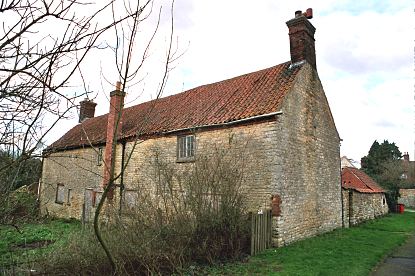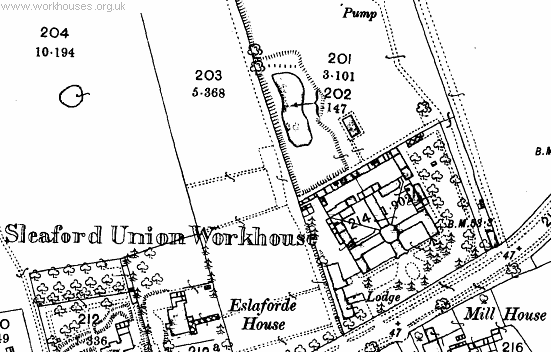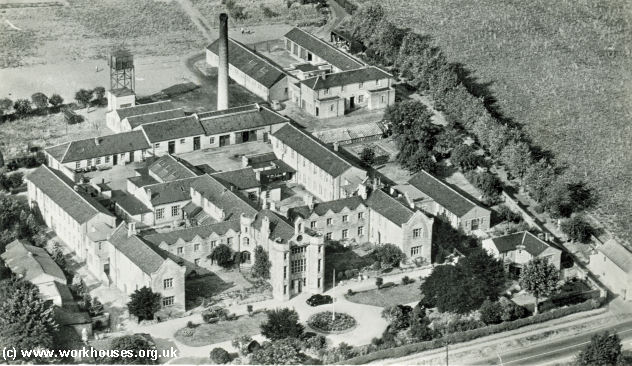Sleaford, Lincolnshire
Up to 1834
A parliamentary report of 1777 recorded parish workhouses in operation at New Sleaford (for up to 22 inmates), Digby (15), Dorrington (8), Newton (10), Ruskington (10), and Waddington (20).
A pair of cottages on Egg Shell Alley in Wellingore, one dating from 1782 and the other from the early 1800s, is reputed to have been the parish workhouse. The property is said to ahve been given to the parish by the Neville family from the Aubourn Hall estate.

Wellingore former parish workhouse, 2004.
© Peter Higginbotham.
Ruskington's workhouse stood at the east side of Chapel Lane, where Water's Farm is now located. In 1875, the old building was described as "constituted of native stone, timbered with wood in the rough, and covered over with reed thatch, large open chimneys, doors and windows… miserable, gloomy cells, with not one ray of comfort belonging to it." (Ambler, 1970)
After 1834
Sleaford Poor Law Union was formed on 20th September 1836. Its operation was overseen by an elected Board of Guardians, 58 in number, representing its 56 constituent parishes as listed below (figures in brackets indicate numbers of Guardians if more than one):
County of Lincoln: Ashby-de-la-Lound, Aswarby, Aunsby, Asgarby, Anwick, Billinghay (2), Blankney, Bloxholme, Branswell, Burton Pedwardine, Cranwell, Culverthorpe, Dembleby, Digby, Dorrington, Evedon, Ewerby, Great Hale, Holdingham, Leasingham, Little Hale, Heckington, Helpringham, Howell, Kelby, North Kyme, South Kyme, Kirkby Green, Kirkby-le-Thorpe, Leadenham, Martin, Newton, New Sleaford (2), Old Sleaford, Osbournby, Quarrington, North Ranceby, South Ranceby, Roxholme, Roulston, Ruskington, Scopwick, Screddington, Stow-cum-Threckingham, Walcot near Falkingham, Scot Willoughby, Silk Willoughby, Spanby, Swarby, Swaton, Thorpe Tilney, Timberland, Walcot-near-Billinghay, Wellbourne, Wellingore, Wilsford.
The population falling within the Union at the 1831 census had been 19,832 — ranging from Scot Willoughby (population 24) to New Sleaford (2,450). The average annual poor-rate expenditure for the period 1834-36 had been £9,083 or 9s.2d. per head.
The new workhouse was built in 1837-8 on a site on the north side of East Gate to the north-east of Sleaford. Its construction cost £4,000. The architect was William J Donthorn who was also responsible for a number of Norfolk workhouses such as Aylsham and Freebridge Lynn. His Sleaford design was for 181 inmates and followed his characteristic Tudor style. Its foreshortened cruciform layout was similar to his design at Ely. Its location and layout are shown on the 1889 map below:

Sleaford workhouse site, 1889.
After 1930, the workhouse became a Public Assistance Institution and was later known as Slea View.

Sleaford workhouse from the south.
© Peter Higginbotham.
The buildings have all been demolished.
Staff
Inmates
Records
Note: many repositories impose a closure period of up to 100 years for records identifying individuals. Before travelling a long distance, always check that the records you want to consult will be available.
- Lincolnshire Archives, St. Rumbold Street, Lincoln LN2 5AB. Holdings include: Guardians' minute books (1836-1930); Admissions and discharges (1896-1939); Births (1914-29); Creed register (1904-40); Offences and punishment book (1914-48); etc.
Bibliography
- Ambler, R.w. (1970) A Nineteenth Century Village Annalist: Thomas Ogden of Ruskington. (In Lincolnshire History and Archaeology, No. 5, p.79).
- Marshall, Fred and Marshall, John (2008) Bastard Brat — the memoirs of Fred Marshall who was born in the Sleaford workhouse in 1909 and grew up in rural Lincolnshire, experiencing the joys and hardships of a way of life long since gone. Available from John Marshall, 12 Morningside, Dawlish, Devon EX7 9SL. tel. 01626-888798
Links
Unless otherwise indicated, this page () is copyright Peter Higginbotham. Contents may not be reproduced without permission.


